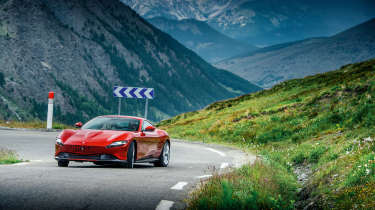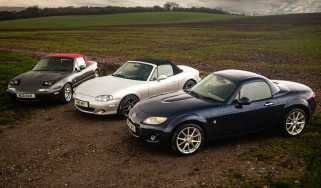Ferrari Roma – ride and handling
Coupe or Spider, the Ferrari Roma’s chassis is superbly configured for fast road driving
You get the first clue that dynamically the Ferrari Roma is going to be a bit special within yards. Leaving the hotel on the international press launch we found ourselves on cobbled streets, all that comes through is a soft, quiet pattering. A little further on, some unavoidable, horribly broken asphalt also rolled beneath the Roma’s wheels with remarkably little fuss. Even in the UK and with the roofless Roma Spider, over the acursed motorway expansion joints it takes the edge off like few cars of any kind can.
But don’t go thinking that the Roma is some sort of lazy GT with a chassis made of blancmange, a car that has prioritised ride comfort above all else. This ride quality is a result of superb wheel control and comes with satisfying dynamic precision rather than at the expense of it.
> Ferrari 12 Cilindri 2025 review – 819bhp super GT tested on road and track
On first rolling away, the steering weight felt a little light, but that was the last time thoughts of the heft at the wheel materialised, a sure sign that it’s very well judged. It feels connected right on centre, responsive to the smallest inputs, but it’s not jumpy, not overly bright. In no time at all the Roma feels direct and confident yet calm and refined.
More reviews
The further you drive the Ferrari Roma, the more impressive it is as a sports GT. Refinement is good, the seats will still be comfortable after almost 12 hours at the wheel, and the view is pretty special too; the way the front wings rise to help you judge the car’s width and the bonnet bulge in the middle are reminiscent of the 550 Maranello.
In creating the Spider convertible, Ferrari adapted the engine and gearbox responses to cater for the small difference in both weight and weight distribution but did nothing to alter the car’s characteristics. The same is true of the chassis with the Roma coupe and Roma Spider sharing spring rates and settings for the adaptive dampers. In Sport mode, a downward press on the Manettino will switch these dampers to the ‘bumpy road’ setting to bring extra compliance. So adept is the Roma’s chassis setup, however, that only the worst British B-roads will have your thumb reaching for it.
The Roma is a Ferrari GT that comes with all the sports car electronics. These include Side Slip Angle Control (SSC) 6.0, Ferrari Dynamic Enhancer (FDE), E-Diff3 and F1‑TCS, and I guess if we’d got time at Fiorano the Roma would have impressed with its balance and poise. Even scratching around the narrow, hairpinned roads of our alpine test route on the car’s international launch, it feels properly handy: responsive, balanced and grippy.
Drive it to the limit of front grip – if you dare – and you’ll be flying, occasionally leaning heavily on the powerful (and standard) carbon-ceramic brakes with their fine feel. Get on the power early to give the rear its share of the workload and traction control quietly asserts itself, releasing the torque only once the car is pretty much straight and the traction is undefeatable. Just as you’d hope, then.
Flick the Manettino to ESC Off and you appreciate just how much grip there is and how hard the E-Diff works to maintain traction. Even once you’ve turned in sharply to a hairpin, it takes a proper slug of throttle to unstick the rear. Once it’s out there, the Roma feels comfortable with a twist of opposite lock and comes back into line reasonably neatly, and it’s much the same in the wet, the rear axle finding a surprising amount of grip and traction.





